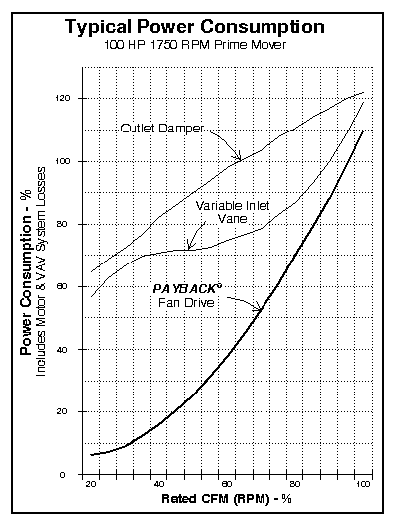|
Changing the output speed of the load will take advantage of the pump or fan curve and will save energy according to the laws of affinity. The PAYBACK drive takes advantage of the affinity laws on variable torque loads such as fans and pumps and does so without altering the voltage or interrupting power to the motor. Even with the motor running continuously, the current and KW required by the motor changes according to the actual load, i.e.: -loading and unloading of the motor by varying the speed of the load via magnetic coupling between the motor and the load. What you always pay for is the amount of KW used and even with the motor running continuously, the difference in the amount of kw required of any 3 phase motor from no load to full load is very significant. As example: 7-1/2 h.p. motor/3phase/60hz (Typical Blower application)
Even greater advantages from full load to no load are realized as the motor h.p. size increases.
The PAYBACK drive is electrically isolated from the motor and in
effect operates as an infinitely variable, frictionless clutch (magnetic
coupled drive), and allows the motor to operate as it was originally
designed, at full speed continuously, and with pure uninterrupted
ac power. Unlike VFDs, regardless of the PAYBACK drive's operating speed, the motor never sees any additional heating contributed by the drive. In fact, all of the additional heat is dissipated by the drive itself, via slip, and not the motor. Since every PAYBACK drive is sized generously to handle the horsepower on (Variable torque loads), this drive heating is minimal and a moot point with these types of loads. Because of the nature of the descending torque load itself, the PAYBACK drive takes advantage of the energy savings with variable speed. In constant torque applications, the drive must be properly sized to allow for the additional drive heat dissipation at the lower speed ranges, however there is no additional demands on the motor other than the conventional no load to full load conditions, the same as in fixed speed operation considerations. PAYBACK drives also work very well in many of these applications, such as conveyors, machine tools, etc., as variable voltage, constant current, or closed loop methods, and are not offered as an energy saving product in these particular situations, but are very reliable, are very low maintenance, and do not require highly skilled service. |
 As a result, the power
curves are very similar to a VFD on variable torque loads and the
KW savings are significant as well. As a general rule, PAYBACK drives
are more efficient at the top end of the curve and VFD's are more
efficient further down the curve. Since fans are generally sized
to run at 40 to 100% speed in real world applications, and when
considering initial cost, ease of installation and ultra solid reliability,
the PAYBACK system usually provides the fastest payback.
As a result, the power
curves are very similar to a VFD on variable torque loads and the
KW savings are significant as well. As a general rule, PAYBACK drives
are more efficient at the top end of the curve and VFD's are more
efficient further down the curve. Since fans are generally sized
to run at 40 to 100% speed in real world applications, and when
considering initial cost, ease of installation and ultra solid reliability,
the PAYBACK system usually provides the fastest payback.